Horticulturists hold magnolias in high regard as one of the oldest and most beloved types of flowering trees and shrubs.
These plants have enamored generations with their fragrant blossoms and iconic foliage, but do you have room for one in your landscape?
How fast do magnolia trees grow? Magnolias have a varied growth rate depending on the species and conditions. On average, magnolias grow 1 to 2 feet per year. However, with proper care, some magnolia trees can experience faster growth. Generally, the deciduous varieties will grow slightly faster than the evergreen magnolias.
Ready to jump in with both feet and learn all there is to know about magnolia trees? We’ll cover types, appearance, growth, growing conditions and care, common issues, and much more, so let’s get started.
Magnolia Tree Overview
Magnolias are among the most timeless and elegant of all flowering trees and shrubs.
They captivate not only with their exquisite blossoms but also with their unique seed pods and architectural presence in a landscape.
With foundational knowledge of magnolia’s appearance, types, and growth habits, it becomes evident why these trees and shrubs hold a cherished place in many landscapes.
Whether you’re looking to plant a solitary specimen tree or design an entire magnolia garden, understanding their characteristics ensures a thriving, vibrant space.
Types of Magnolia Trees
Magnolias offer a delightful variety, catering to different garden needs and aesthetic preferences:
Evergreen Varieties
Evergreen magnolias, like the Southern magnolia, are renowned for their large, dark green leaves that remain throughout the year.
Their leathery texture and glossy finish offer a visual and tactile delight. Their ability to retain foliage makes them an excellent choice as a shade tree or a privacy screen.
Deciduous Varieties
Deciduous magnolias, on the other hand, shed their leaves during fall.
They give gardens a dynamic character, transitioning from bare, skeletal forms in winter to lush green in summer and a riot of colors in autumn.
The Bigleaf magnolia, known scientifically as Magnolia macrophylla, stands as a testament to nature’s grandeur, flaunting the largest simple leaf and single flower of any native plant in North America.
Dwarf Magnolias
For those with limited space or seeking a low-profile centerpiece, dwarf magnolias like the ‘Little Gem’ provide the beauty of magnolias in a compact form.
They can serve as a shrub or small tree, making them ideal for urban gardens or patios.
Specialty Varieties
The Saucer magnolia (Magnolia x soulangeana) with its impressive tulip-shaped flowers and the Star magnolia (Magnolia stellata) with radiant white flowers appearing in early spring before the leaves are two beloved specimens.
Another notable mention is the Sweetbay magnolia (Magnolia virginiana), native to North America, which boasts creamy white flowers with a hint of lemony fragrance.
Tree Appearance & Size
Magnolia trees present an impressive stature, often maturing to heights between 20 and 40 feet, though some, like the Southern magnolia, can even reach up to 80 feet in their native habitats.
Their growth habit varies. While some maintain a pyramidal or conical shape, others, especially the shrubby types like the Sweetbay, tend to spread out.
Their bark is often smooth and gray, providing a lovely contrast to their vibrant foliage and blossoms. But what steals the show are their flowers.
Ranging from a few inches across in some species to almost a foot in diameter in others, their petals—whether numbering at 6 or as many as 12 petals in some cultivars—can vary from pristine white to deep pink and even reddish-purple.
Magnolia Flowers
The heart of any magnolia’s appeal is undoubtedly its flower.
Blossoming in a range of shapes—from the tulip-shaped blooms of the Saucer magnolia to the star-like form of the Star magnolia—each type brings its unique charm.

Magnolia flowers also vary greatly in size, with some petite varieties measuring just 3 inches across, while others, especially those on the Saucer and Bigleaf magnolias, can be up to 10 inches across.
Fragrance is another captivating aspect. Some flowers, such as those of the Southern magnolia, emanate a potent, sweet, and lemony aroma that can perfume an entire garden.
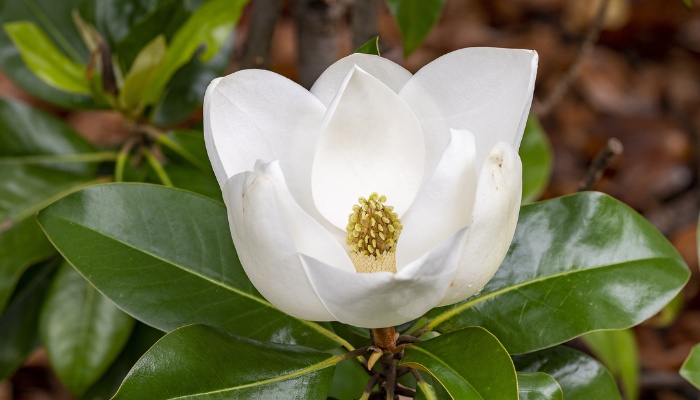
Others might offer subtler fragrances, but they are equally enchanting.
Magnolia Leaves
When not in bloom, magnolias continue to enchant with their foliage. The evergreen varieties flaunt glossy, leathery leaves that can be up to a foot long, like those of the Magnolia grandiflora.
The undersides of these leaves often exhibit a brownish, velvety texture, which adds a depth of character, especially when rustled by the wind.

Deciduous varieties have a different allure. The Bigleaf magnolia’s name is a direct nod to its massive leaves, which can be up to 24 inches long.
These leaves give the tree a tropical appearance, and in the fall, they turn a golden yellow, adding another layer of visual appeal.
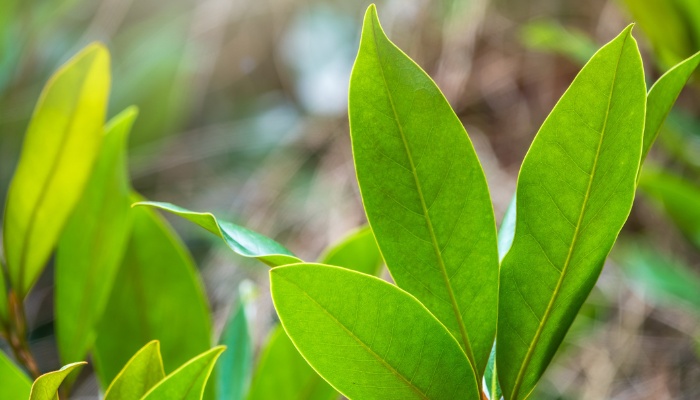
Magnolia Seed Pods
After the magnolia’s bloom has run its course, many types produce intriguing seed pods. These can be quite ornamental in their own right.
The Cucumber Tree magnolia (Magnolia acuminata) derives its name from the cucumber-like appearance of its seed pods.
When these pods mature and burst, they reveal bright red seeds, adding yet another element of interest to the tree.

Growth Habit & Rate
Different magnolias have different growth habits from the stately upward reach of the Southern magnolia to the more shrubby, spreading habit of the Sweetbay magnolia.
On average, with optimal care, you can expect most magnolias to grow between 1 and 2 feet annually. However, dwarf varieties, being compact, have a slower growth rate.
Magnolia Trees in Fall & Winter
Fall and winter bring out distinct facets of magnolia trees, especially in the deciduous varieties.
As the days grow shorter and temperatures drop, the lush green canopy of many magnolias transforms.
Deciduous varieties, like the Bigleaf magnolia, drape themselves in hues of golden yellow, offering a stark contrast to the evergreen backdrop in many gardens.
This shift not only brings visual warmth to the cooling days but also paints a picturesque scene, especially when morning frost delicately traces each leaf.
While magnolia flowers, especially those that appear in early spring, can be easily damaged by frost, their tough, woody structure ensures resilience.
It’s fascinating to see a frost-covered magnolia stand tall, its sturdy branches defying the cold.
Deciduous magnolias, having shed their leaves, showcase a network of branches that can look especially mesmerizing under a blanket of snow.
The often gray bark provides a dramatic contrast to snowy landscapes, and the unique branching patterns become evident, making them a focal point even in the dormant season.

Magnolia Grow Zones
The adaptability of magnolias to various climates is impressive. From the humid warmth of the southern U.S. to cooler northern climates, there’s likely a magnolia suited for most regions.
Magnolia trees, being diverse, have species and cultivars that can grow from Zone 5 to Zone 9.
The Star magnolia, for instance, is cold-hardy and can thrive in Zone 5. The Southern magnolia prefers warmer climates and is usually found in Zones 7 to 9.
With many cultivars available, you can find varieties that are suited for both warmer and colder climates.
Magnolias are versatile, with some varieties being frost-resistant while others prefer the milder climate of the southern states.
The Sweetbay magnolia, for example, can be found growing as far north as parts of New York and as far south as Florida, showcasing its adaptability.
When choosing a magnolia for your garden, it’s essential to factor in not just the USDA Zone but also the specific microclimate of your location.
Factors such as soil pH, elevation, and proximity to bodies of water can influence a magnolia’s health and growth.
It’s always advisable to consult with local nurseries or horticulturists to ensure you’re selecting the best magnolia variety for your region.
Magnolia Tree Care and Maintenance
Caring for magnolias is a harmonious blend of patience, knowledge, and attention to detail.
While magnolias are relatively low in terms of care and maintenance, understanding their unique needs ensures their optimal growth and a dazzling display of blooms.
Growing Conditions
Magnolias thrive in full sun to part shade. While they appreciate the warmth of the sun, particularly in the early morning, they also benefit from some protection during the hottest parts of the day.
These trees prefer slightly acidic to neutral soil. Alkaline soil can lead to chlorosis, causing the foliage to turn yellow.
Magnolias flourish in well-draining soil enriched with organic matter. Whether it’s loamy or has a clay constitution, ensuring good drainage is crucial.
In conditions where drainage is a challenge, consider elevating the planting site or opting for raised beds.
Watering Needs
Newly planted magnolias need consistent moisture. It’s vital to keep the plant well-watered, ensuring the soil remains moist but not waterlogged.
Once established, they can handle short periods of drought but appreciate deep watering during prolonged dry spells.
Mature magnolias have a more extensive root system and can extract moisture from deeper soil layers.
However, during extremely dry periods, it’s a good practice to water them deeply to prevent stress.
Fertilization
While magnolias aren’t heavy feeders, they benefit from a balanced, slow-release fertilizer applied in early spring. This one is excellent.
Opt for one specially formulated for acid-loving plants to cater to their pH preference.
Pruning
Magnolias don’t require rigorous pruning. However, it’s advisable to prune any dead or diseased branches to maintain their health.
For deciduous varieties, the best time is late winter or early spring before the leaves appear. Evergreen magnolias can be pruned in mid-spring after the major bloom cycle has passed.
Remember that pruning just for shaping might reduce the number of blossoms for the next season.
Always use sharp tools to ensure clean cuts, minimizing the risk of pest infestations or diseases.
Mulching
Mulching serves a dual purpose for magnolias. It retains soil moisture and regulates temperature, especially during frosty winter days.
Using organic mulch like pine bark or leaves also gradually enriches the soil as it decomposes. Ensure the mulch is spread evenly around the base, but avoid piling it against the trunk.
Cleanup Tasks
Fallen magnolia leaves, especially from deciduous varieties, can be a sight in autumn. Regular cleanup prevents fungal growth and reduces hiding spots for pests.
If the fallen leaves show signs of disease, it’s advisable to dispose of them rather than composting them to prevent the spread of pathogens.
The large and unusual seed pods can also be problematic when they fall to the ground. Picking them up is advised to avoid damage to mowers and delicate feet.
Magnolia Tree Diseases and Pests
Magnolias, though known for their resilience and relatively hassle-free care, are not entirely immune to certain diseases and pests.
Being aware of these issues can help you intervene early, ensuring the longevity and vitality of your magnolia.
Magnolia Scale
This is one of the most common pests affecting magnolias. Scale insects suck sap from the plant, leading to yellowing leaves and a general decline in health.
The honeydew excreted by these pests can also lead to the growth of sooty mold.
Solution: Horticultural oil sprays during the dormant season can help control scale. Regular monitoring and prompt removal of infested branches can also curb their spread.
Verticillium Wilt
This soil-borne fungus can cause magnolias to display wilted, yellowed, and scorched-looking leaves.
The fungus affects the tree’s vascular system, hindering water movement.
Solution: It’s crucial to avoid planting magnolias in areas where plants affected by this fungus previously grew. If an existing tree gets infected, it’s best to consult an arborist for targeted treatment and potential removal.
Leaf Spot
While generally not lethal, leaf spot fungi can cause aesthetic issues with dark spots on magnolia leaves.
Solution: Ensuring good air circulation around the tree, avoiding overhead watering, and promptly removing affected leaves can help in managing this disease.
Tulip Tree Scale
Similar to magnolia scale, these pests can lead to the weakening of the tree. They also excrete honeydew, which can attract ants and promote sooty mold growth.
Solution: Dormant oil sprays and regular tree inspection can help in managing and preventing an infestation.
Magnolia Borer
These insects can damage young magnolias by boring into their trunks. The damage can hinder the tree’s growth and even lead to its death.
Solution: Regularly inspect the tree for any signs of borer activity. If detected, it might be necessary to use an appropriate insecticide or consult a tree care specialist.
Aphids
These tiny pests suck sap from magnolias, leading to curled and yellowed leaves. They also produce honeydew, leading to sooty mold.
Solution: Releasing natural predators, such as ladybugs, can keep aphid populations in check. In severe cases, insecticidal soap or neem oil can be used.
Propagating Magnolia Trees
Propagation might seem daunting, especially for novice gardeners, but with a bit of research, patience, and care, it’s a rewarding endeavor.
While some methods are straightforward, others demand precision and patience. However, the joy of seeing a young magnolia sprout from your efforts is unparalleled.
Here’s a closer look at the key propagation methods:
Starting From Seed
Wait for the magnolia seed pods (often red or orange) to mature and open. Harvest these seeds and clean off the fleshy outer coating.
Magnolia seeds typically require cold stratification to germinate. This means they need to be exposed to cold temperatures for an extended period.
You can achieve this by placing the seeds in a bag with slightly moist peat moss and storing them in a refrigerator for about 3-6 months.
Once stratified, plant the seeds in a well-draining potting mix, ensuring they are just beneath the soil surface.
Water well, and place the container in a location with indirect sunlight. With the right conditions, seedlings should emerge in a few weeks.
Air Layering
This method involves inducing roots to form on a branch while it’s still attached to the parent tree.
Make an upward slanting cut about one-third through a healthy, mature branch.
Prop this cut open with a small piece of wood or toothpick, apply rooting hormone (I use this one), and wrap the area with moist sphagnum moss.
Cover this with plastic wrap and secure both ends. In a few months, when roots have formed inside this moss, the branch can be cut below the rooted area and planted.
Ground Layering
This involves bending a low branch down to the ground and covering a part of it with soil, ensuring that the tip emerges from the soil.
Over time, the buried part of the branch will develop roots. Once a strong root system is established, the new plant can be severed from the parent and transplanted.
Rooting Cuttings
Take semi-hardwood cuttings of about 4-6 inches during summer. Remove the lower leaves, and dip the cut end in a rooting hormone.
Plant this in a pot with a mix of peat and sand. Place the pot in a location with high humidity and indirect sunlight. Once the cuttings develop a good root system, they can be potted individually.
Grafting
This method involves joining a piece of a magnolia tree (the scion) onto a robust root system of another tree (the rootstock).
The chosen scion, which is a young shoot with several buds, is joined with the rootstock in such a way that their cambial layers align. The union is tightly bound and left to heal.
Over time, the scion grows and derives nutrients from the rootstock, producing a new tree. This technique is commonly used to reproduce cultivars that don’t come true from seed.
Magnolia Tree Varieties
Magnolias have been a gardener’s favorite for centuries, primarily because of their breathtaking flowers and stately presence.
Though all magnolias share certain similarities, each variety possesses unique characteristics that make it stand out. Let’s dive into some of the most renowned and beloved magnolia varieties:
Southern Magnolia

An iconic magnolia, the Southern magnolia (Magnolia grandiflora) is native to North America. Its large glossy leaves are dark green on top and have a leathery texture.
The white flowers bloom in late spring and early summer, emitting a lemony fragrance. Mature trees can grow up to 40 feet or more.
As the name suggests, this variety thrives in southern climates but is cold-hardy enough to survive in regions as far north as Zone 5.
Saucer Magnolia
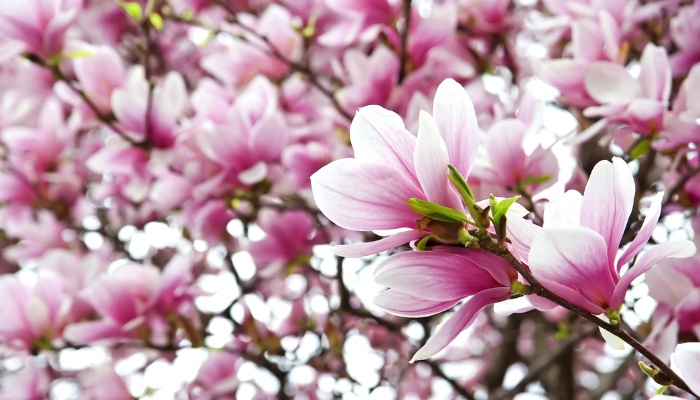
One of the most popular magnolia varieties, the Saucer magnolia (Magnolia x soulangeana) is a deciduous tree known for its stunning large flowers that resemble saucers.
Colors range from white to pink and reddish-purple, and the blooms appear in early spring before the leaves.
This magnolia is a hybrid, resulting from a cross between the Lily magnolia and the Yulan magnolia.
Star Magnolia

The Star magnolia variety (Magnolia stellata) is known for its star-shaped white flowers, which burst forth in early spring.
It’s a smaller specimen, making it ideal for smaller gardens. The petals, often numbering around 12, have a delicate appearance, and the overall blossom has a fragrant aroma.
Jane Magnolia
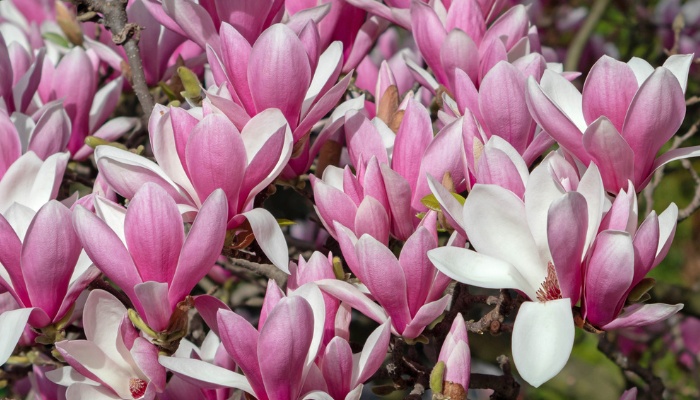
Part of the “Little Girl” series of magnolias, Jane magnolia blooms later than many other varieties, reducing the risk of frost damage.
It showcases reddish-purple flowers on the outside with white on the inside. Its compact size makes it suitable for smaller spaces.
Little Gem
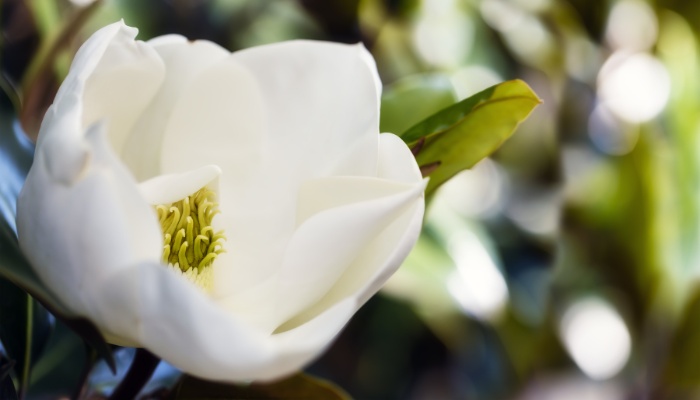
A compact cultivar of the Southern magnolia, the Little Gem variety is perfect for smaller gardens. It bears the signature white flowers of its larger counterpart but on a significantly smaller scale.
Ann

Another member of the “Little Girl” series, Ann is known for its purplish-red flowers. It’s a late bloomer, providing vibrant spring colors.
Butterflies

This deciduous magnolia is named for its golden-yellow flowers, reminiscent of butterflies.
Butterflies magnolia is an early bloomer and offers a fresh hue different from the typical magnolia shades.
Royal Star

A cultivar of the Star magnolia, the Royal Star is prized for its fragrant double flowers. Blooms are a radiant white and slightly larger than the typical Star magnolia.
Sweetbay Magnolia

The Sweetbay variety (Magnolia virginiana) can be evergreen or deciduous based on the climate.
It produces creamy-white flowers with a vanilla-like fragrance. The leaves are dark green on the top with silvery undersides.
Magnolia Companion Plants
The magnificence of magnolia trees makes them an undoubted focal point in gardens.
When choosing companion plants, it’s crucial to pick those that can tolerate the specific conditions magnolias create, mainly the shade they cast, allelopathy, and the competition for nutrients and water.
Fortunately, there are several plants known for their hardiness that can add diversity and color under a magnolia’s canopy:
- Ferns: Most ferns adore shade, and their delicate fronds offer a great contrast to the larger magnolia leaves. Consider varieties like the Christmas fern or lady fern for best results under magnolias.
- Hostas: These plants thrive in shady conditions and are available in a plethora of colors, sizes, and leaf patterns. Their broad leaves complement the ground beneath magnolias.
- Heucheras (Coral Bells): With their vibrant foliage available in shades ranging from burgundy to lime green, heucheras can brighten the underplanting of a magnolia tree.
- Bleeding Hearts: This perennial offers a romantic touch with its heart-shaped flowers. The foliage is feathery, creating an interesting texture beneath the magnolia.
- Liriope: This tough, grass-like plant can handle the shade and root competition. Its purple or white flower spikes add an extra splash of color.
- Periwinkle: A ground cover with glossy leaves and blue or purple flowers, periwinkle (vinca) can spread and cover the soil beneath a magnolia, offering both beauty and weed prevention.
- Hellebores: Often referred to as Lenten roses, these early spring bloomers offer lovely blossoms in shades of green, pink, white, and purple. They’re tolerant of deep shade and can be a great early-blooming companion for magnolias.
- Solomon’s Seal: This perennial has graceful, arching stems with pairs of greenish-white flowers that hang down like bells. It can thrive in the dense shade and creates a peaceful woodland feel.
- Ajuga: An attractive ground cover that offers both colorful foliage and flower spikes. Its thick growth can also help suppress weeds.
- Astilbe: Their feathery flower plumes, which range from white to pink to red, can brighten up the shaded ground under magnolias.
Best Places To Buy Magnolia Trees
You’ll likely be able to find magnolia trees for sale at local garden centers and nurseries, but if you’d like a specific variety, your best bet is a reputable online retailer.
Here are some of the best that I personally use and recommend:
Closing Thoughts
Magnolias are more than just trees and shrubs; they’re a legacy. Their majestic blooms, coupled with their stately presence, make them a cornerstone in many landscapes.
Whether you’re drawn to the iconic Southern magnolia or the less common Cucumber tree, there’s no denying the magnolia’s charm.
With proper care, they’re not just a seasonal delight but a lifetime companion.
